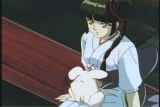

Quick Links:
Vampire Princess Miyu, TV Series
Following in the footsteps of the heavily atmospheric OVAs, the Vampire Princess Miyu TV series is a second chance to delve into Kakinouchi Narumi's vision of the Japanese occult. Cast in a slightly different chronology and setting than either the manga or the OVA, this series provides a lengthier exploration of Miyu's sorrow-filled destiny. Joined by her old servant and friend, Larva, and a new, more benevolent minor Shinma, Shiina, Miyu reluctantly acts out her role as Watcher / Guardian, returning stray Shinma (God Demons) to the Dark.
The plot for the TV series is largely episodic, playing out like a series of loosely connected short stories until the finale. Each episode follows roughly the same pattern-introduction of a new Shinma, background detail on the minor characters involved, then a battle followed by judgment on all involved. The battles are nothing spectacular-instead, the strong point of the episodes involves the effective use of pathos for the personages introduced, as well as the use of the fantastic, in constructing the occult elements driving each side story. At the same time, there is also a strong ending story arc for those who follow the show to its conclusion. If you enjoyed the OVA series, like me, the TV series should be right up your alleyc. For those new to the series, be aware that the plot of Vampire Princess Miyu is focused on grim tragedy, dramatically playing out with few respites of humor.
The characters of Vampire Princess Miyu are a mixed bag. You don't get much background or deep character development on the main characters, like Miyu, Larva, and the yuki-onna (snow witch) Reiha until later in the series, leaving them to act out mostly predictable scripts for their portion of the early show. At the same time, they each have striking character designs-you can tell by my sig pic that I've always found Larva to be an intriguing mystery, especially with his new scythe ^_^ Instead, the main caricatures early on are reserved for the minor characters, whose lives unfold as skilful Shinma-cursed tragedies. These side characters highlight the exploration of the sadness of the human condition and psyche, if you are interested in that kind of thing. Few other anime series are so bold in examining the darker side of humanity.
The animation of Vampire Princess Miyu is very atmospheric, relying more on stills than animation to convey the mood of the drama. There may not be much fluidity or pizzazz in combat sequences, but there also aren't many repeated frames. Monster designs are a nice blend of the bizarre and the mythical, providing an adequate counterpoint to the standard costumes of the main characters. Since mood is more important than motion in Vampire Princess Miyu, the manga-esque reliance on stills is quite appropriate, not at all detracting from the presentation of the series.
The music of Vampire Princess Miyu comprises one of my favorite soundtracks, fitting the tone of the show perfectly. The background music provides a haunting blend of traditional Japanese music and classical music, adding up to a very stylistically distinct and memorable aural experience. I especially like the enchanting use of the flute and ocarina. The opening and closing songs could have been a wee bit better, but they are still strong constituents of this inspired soundtrack.
Overall, the Vampire Princess Miyu TV series offers an extended excursion into a grimly unique vision of the Japanese occult. The grim subject matter is presented from a fairly tragic and sometimes controversial perspective-one episode was not aired on TV Tokyo because of the similarities to a contemporary murder in Kyoto. While I personally love the series, its tone and episodic presentation may appeal more to a niche audience. For those not familiar with the series I'd recommend seeing the domestically released OVA series first, to get some background on Miyu and Larva and to see if you enjoy the atmosphere. There are slight continuity differences from the OVA series in the TV series, but in general I think it would help to start the series with some understanding of Miyu's background and relationship with Larva, to better appreciate what is going on in her mind independent of the more formulaic dialogue.
Distributor: TOKYOPOP Creator: AIC Released: 1997
Plot: B Character Design: B Animation Quality: C Music: A Overall: B



